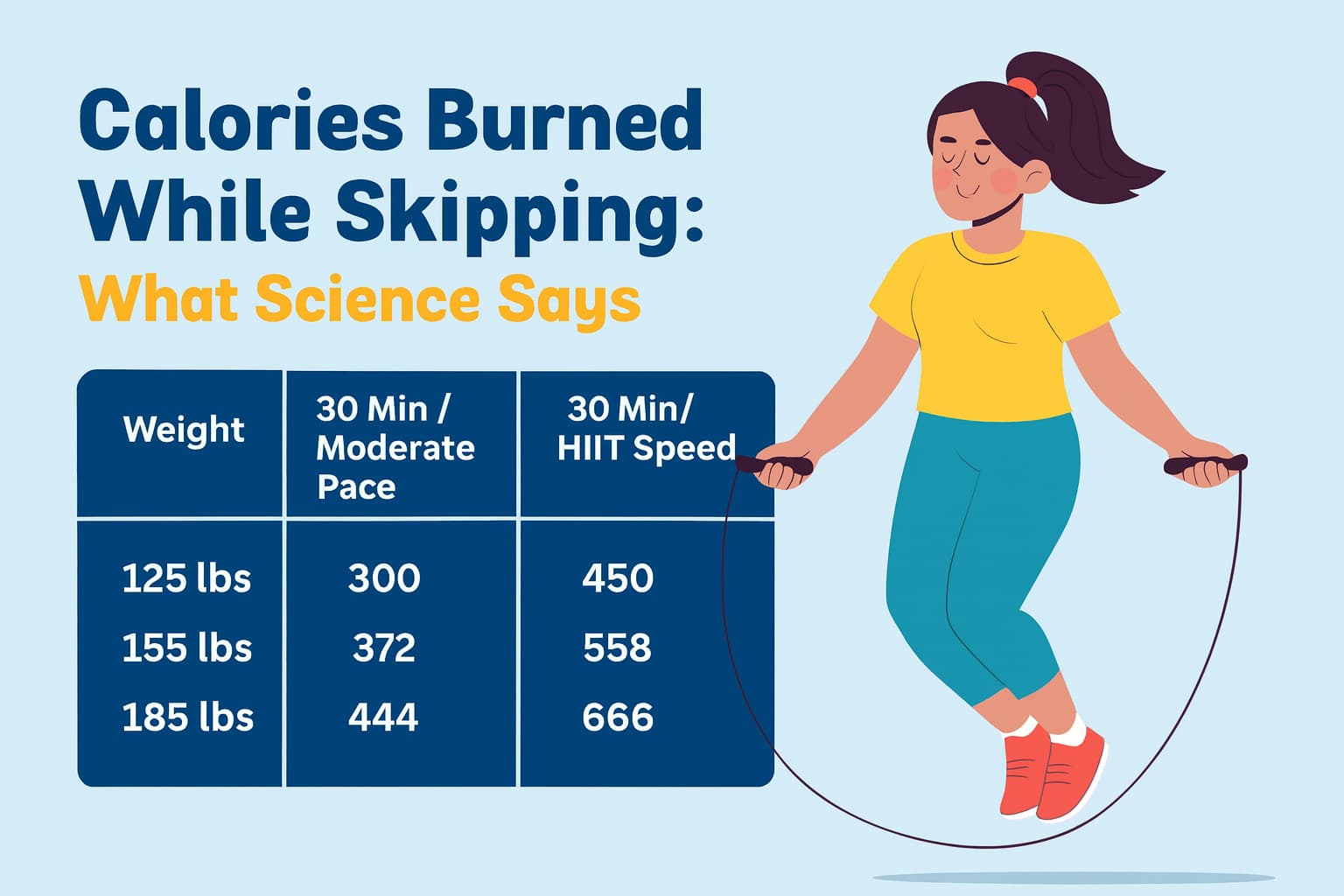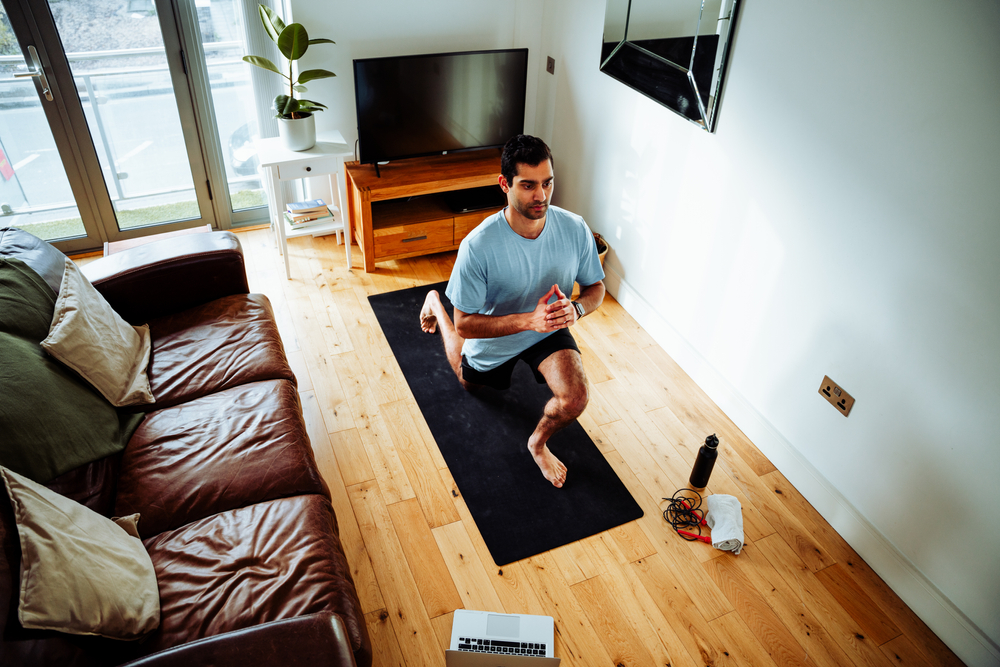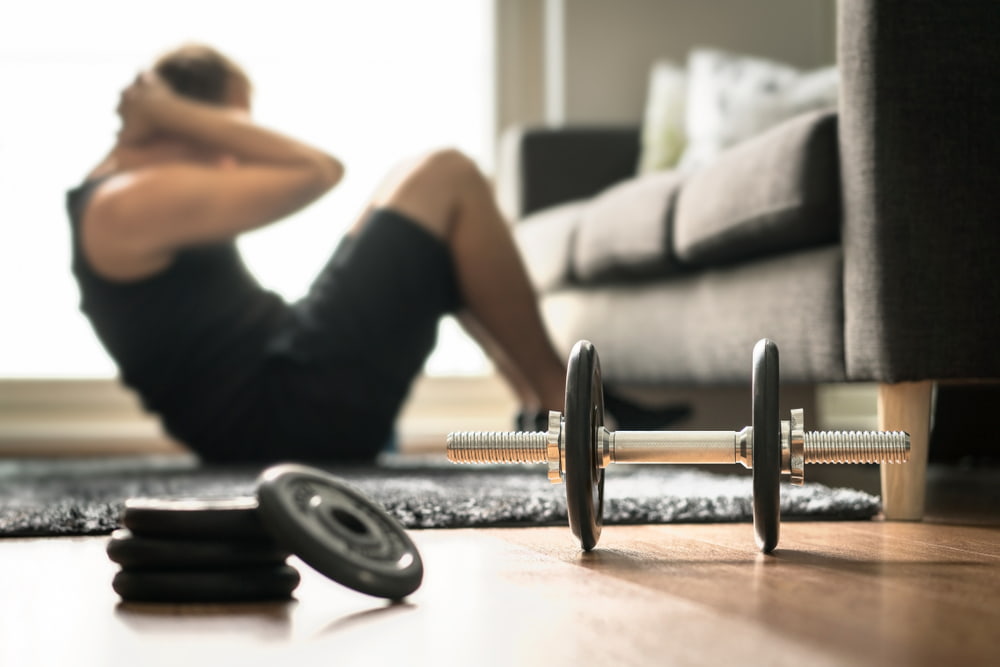Does Skipping Really Burn Fat? The Science Behind Belly Fat Reduction at Home


How Skipping Works as a Cardio Exercise
Skipping, also known as jump rope training, is one of the most efficient aerobic workouts for improving heart health and burning fat at home. When you skip, your body repeatedly lifts off the ground using quick, rhythmic movements that cause a rapid increase in heart rate. This elevated heart rate improves oxygen circulation throughout the body, forcing your cardiovascular system to work harder much like running or cycling. The result is a stronger heart, improved lung capacity, and a higher level of overall endurance.
From a physiological standpoint, skipping stimulates both the aerobic and anaerobic energy systems. During the first few minutes, your body primarily burns stored glycogen (carbohydrates) to fuel movement. As the session continues and glycogen stores begin to deplete, your body transitions into fat oxidation mode the process where fat is broken down into energy. This is the stage where skipping starts to become an effective fat-burning exercise, especially for those aiming to reduce belly fat or improve body composition.
Consistent skipping also builds coordination, balance, and agility, as it synchronizes upper and lower body movements with rhythm and timing. Over time, this full-body motion enhances muscular endurance in the calves, core, shoulders, and forearms. Skipping can be easily modified for intensity — from steady-state cardio to high-intensity interval training (HIIT) depending on your fitness level and goals.
Research suggests that a 15-minute skipping session can burn approximately 200–300 calories, depending on your body weight, speed, and rope technique. This makes it one of the most time-efficient home workouts for both cardiovascular fitness and fat reduction. Plus, since all you need is a jump rope and a small open space, it’s an ideal exercise for busy individuals who want maximum results with minimal equipment.


Calories Burned While Skipping: What Science Says
If you’ve ever wondered exactly how many calories skipping burns, science has a clear answer it’s one of the most calorie-efficient exercises you can do at home. Skipping, being a high-intensity cardio workout, uses almost every major muscle group in your body. That means your arms, shoulders, legs, and core all work together to keep the rope moving while maintaining balance and coordination. This full-body engagement causes your metabolism to rise, leading to a higher rate of calorie expenditure even after the workout ends.
According to Harvard Health Publishing, a person weighing around 155 pounds (70 kg) can burn approximately 372 calories in just 30 minutes of skipping at a moderate pace. Meanwhile, someone weighing 185 pounds (84 kg) can burn close to 444 calories in the same duration. At a higher intensity, these numbers can reach 500–600 calories per half hour, making skipping comparable — and sometimes superior to running or cycling in terms of calories burned per minute.
To get an estimate tailored to your own body, you can use a calorie calculator for skipping, which considers your body weight, skipping speed, and workout duration. Generally, a moderate session burns about 10–15 calories per minute, while high-intensity skipping (like double under or HIIT intervals) can push this number to 18–20 calories per minute.
What makes skipping even more effective for fat loss is the afterburn effect, scientifically known as EPOC (Excess Post-Exercise Oxygen Consumption). After a high-intensity rope session, your body continues to burn calories for hours as it restores oxygen levels, repairs muscles, and balances hormones. This means you’re still burning fat even while resting a powerful benefit of short, intense skipping workouts.
So, whether your goal is to lose belly fat, tone your body, or simply stay fit, skipping provides one of the best fat-burning returns on your time investment. The science is clear: it’s not just child’s play — it’s a metabolic powerhouse.


Skipping vs Running: Which Burns More Fat?
Both skipping and running are powerful cardio exercises that improve endurance, strengthen the heart, and burn calories. But when it comes to fat loss, especially belly fat reduction, many fitness experts argue that skipping holds a slight edge and science explains why.
Let’s start with calorie comparison. According to studies by the American Council on Exercise (ACE), a person weighing about 70 kg (155 lbs) burns roughly 372 calories in 30 minutes of skipping, while running at a moderate pace (5 mph) burns around 298 calories in the same duration. This means skipping can burn about 20–25% more calories than running, depending on intensity and rhythm. The reason? Skipping engages more muscle groups simultaneously arms, shoulders, core, and legs all move in coordination, increasing overall energy demand.
Another key difference lies in impact and efficiency. Running, especially on hard surfaces, can be stressful for the knees and ankles due to repetitive impact. Skipping, when performed correctly with a cushioned mat or smooth floor, exerts less joint pressure while still keeping your heart rate elevated. It also improves agility, timing, and coordination qualities that running doesn’t emphasize as much.
When it comes to fat oxidation and metabolism, both exercises trigger similar physiological processes. However, high-intensity skipping (HIIT style) alternating between fast bursts and rest intervals stimulates a stronger EPOC effect, meaning your body continues to burn calories long after your workout. This “afterburn” makes skipping a superior choice for busy individuals aiming for maximum fat-burning in less time.
Here’s a quick comparison summary:
| Factor | Skipping | Running |
|---|---|---|
| Calories burned (30 min, 70kg person) | ~372–450 | ~298–350 |
| Muscle groups activated | Full body (arms, core, legs) | Mainly legs |
| Impact on joints | Moderate (if done correctly) | High |
| Space required | Very little | Large area/outdoors |
| Fat-burning efficiency | High (especially HIIT skipping) | Moderate to high |
If your goal is faster fat burning with less strain on your joints, skipping is a clear winner. It’s portable, time-efficient, and equally effective for both men and women. However, alternating between the two can bring the best of both worlds running for endurance and skipping for intensity.
Best Time to Skip Rope for Maximum Fat Loss
Timing can make a surprising difference in how effectively your body burns fat. While skipping is beneficial any time of the day, research and fitness experts agree that certain time windows can optimize fat oxidation and metabolism, helping you get the most out of each session.
Morning Workouts: The Fat-Burning Advantage
Skipping in the morning especially on an empty stomach (fasted state) can enhance fat utilization. After a night’s sleep, your glycogen (stored carbohydrate) levels are lower. When you begin skipping before breakfast, your body taps into stored fat as the primary energy source. Studies published in the Journal of Physiology show that fasted workouts can increase fat oxidation by up to 20–30% compared to fed workouts.
Moreover, a morning skipping session jump-starts your metabolism, keeping it elevated for several hours a phenomenon often called the “metabolic boost.” That means you continue burning calories even after your rope is back in the drawer. Morning workouts also help regulate your circadian rhythm, increase mental alertness, and release endorphins that improve mood for the rest of the day.
Evening Workouts: Strength and Recovery Benefits
Evening skipping sessions have their own advantages. Your body temperature and flexibility peak later in the day, reducing injury risk and improving performance. For many people, skipping after work helps relieve stress, enhance sleep quality, and maintain consistency — which is just as important for long-term fat loss as timing itself. If you’ve eaten earlier meals, the additional glycogen in your muscles can help sustain higher intensity skipping intervals, leading to more total calorie burn in less time.
Finding Your Ideal Time
Ultimately, the best time to skip depends on your schedule and energy levels. If you feel strong and motivated in the morning, take advantage of the fasted-state fat burn. If you’re more energetic in the evening, focus on high-intensity skipping circuits combined with bodyweight moves. The key is consistency skipping four to five times a week for at least 20 minutes per session delivers measurable results regardless of timing.
Pro Tip: Always drink a glass of water before fasted skipping, do a gentle warm-up for 5 minutes, and follow up with a protein-rich meal to aid recovery and muscle repair.


Safety Tips and Common Mistakes to Avoid
Skipping is one of the most efficient fat-burning cardio exercises, but like any physical activity, proper technique and safety precautions are essential to avoid injuries. Whether you’re a beginner or an experienced jumper, following a few simple guidelines will help you make your workouts more effective, joint-friendly, and sustainable.
1. Warm Up Before You Jump
A good warm-up routine prepares your muscles and joints for impact. Spend 5–7 minutes doing light jogging, ankle rotations, shoulder circles, and dynamic stretches. This increases blood flow, reduces stiffness, and prevents muscle strains during skipping.
2. Choose the Right Surface
Avoid skipping on concrete or tile floors, as they can be too hard on your knees and ankles. Instead, use a rubber mat, wooden floor, or gym surface that absorbs impact and offers slight cushioning. A proper surface helps protect your joints and improves bounce control.
3. Use the Correct Rope and Length
Many people use a rope that’s too long or too short, which can ruin rhythm and cause tripping. To find the right fit, stand in the middle of the rope and pull the handles upward they should reach your armpit level. Lightweight speed ropes are great for fat-burning workouts, while thicker ropes add resistance for muscle endurance.
4. Maintain Proper Posture
Keep your body upright, core engaged, and elbows close to your torso. The movement should come mainly from your wrists, not your arms. Avoid high jumps stay low to the ground with soft landings to reduce stress on joints. A mirror or short video check can help correct your form.
5. Don’t Skip Too Fast Too Soon
Beginners often try to jump too quickly, which leads to fatigue and sloppy form. Start with short intervals 30 seconds of skipping followed by 30 seconds of rest and gradually increase duration and speed as your stamina improves. Overtraining can cause shin splints, knee pain, or ankle soreness, so give your body enough rest days.
6. Common Mistakes to Avoid
Skipping without warm-up or cool-down
Landing heavily on heels instead of balls of feet
Holding breath during jumps (maintain steady breathing)
Using a rope with tangled or frayed cables
Ignoring pain signals rest if joints feel sore
Pro Tip:
Always stretch after your session especially calves, hamstrings, and shoulders to aid recovery and flexibility. Pair skipping with foam rolling and hydration for maximum joint health.
By following these safety tips and correcting simple mistakes, you’ll turn skipping into a fun, injury-free workout that supports long-term fat loss and cardiovascular health.
7-Day Skipping Workout Plan for Fat Loss at Home
A well-structured skipping plan helps you burn fat efficiently without overtraining. The key is progressive overload gradually increasing intensity and duration so your body keeps adapting, leading to continuous fat oxidation and metabolic boost.
Here’s a simple 7-day skipping routine that combines calorie-burning, muscle toning, and recovery perfect for beginners to intermediate levels.
Day 1 – Build the Basics (10–12 mins)
Warm-up: 3 mins (light jogging, ankle rotation)
Basic bounce: 30 sec × 3 sets (30 sec rest each)
Alternate foot jump: 30 sec × 3 sets
Cool down: calf and hamstring stretch
Focus on form, not speed. Maintain steady breathing and light jumps.
Day 2 – Endurance and Rhythm (15 mins)
Warm-up: 3 mins dynamic stretching
Basic jump: 45 sec × 3 sets
Boxer step jump: 30 sec × 3 sets
Side-to-side jump: 20 sec × 2 sets
Rest: 30 sec between sets
Cool down: light skipping for 1 minute
Build stamina this day targets cardiovascular endurance.
Day 3 – High-Intensity Fat Burn (HIIT Skipping, 20 mins)
Warm-up: 4 mins
20 sec fast skipping + 10 sec rest × 8 rounds (Tabata style)
1 min slow skip recovery
Repeat cycle 3 times
Finish with 2 mins of core work (plank or mountain climbers)
This is your metabolism booster burns calories for hours post-workout (EPOC effect).
Day 4 – Active Recovery (10 mins)
Light skipping: 1 min × 4 rounds
Walking lunges + squats: 2 sets each
Shoulder rolls and calf stretches
Helps your muscles recover while maintaining blood flow.
Day 5 – Power & Agility (15–18 mins)
Warm-up: 3 mins
High knees skip: 30 sec × 4 sets
Crisscross jumps: 20 sec × 3 sets
Double unders: 10 reps × 3 sets
Cool down: deep breathing + stretching
Great for improving coordination, balance, and fat-burning intensity.
Day 6 – Core & Full Body Burn (20 mins)
2 min skipping warm-up
30 sec skipping + 30 sec bodyweight squats × 5 rounds
30 sec skipping + 30 sec push-ups × 5 rounds
1 min plank hold
Stretch for 3 mins
Combines cardio and strength helps tone arms, legs, and abs together.
Day 7 – Rest or Gentle Movement
Take a full rest day or enjoy a light walk, yoga, or foam rolling.
Focus on hydration and balanced meals rich in lean protein and fiber.
Rest is when your muscles repair, metabolism stabilizes, and fat loss continues.
Pro Tips for Best Results
- Maintain consistency 4 to 5 sessions per week is ideal.
- Stay hydrated and include protein-rich meals post-workout.
- Combine skipping with clean eating and 7–8 hours of sleep.
- Track progress aim to increase duration or intensity weekly.
When done consistently, this 7-day skipping routine can help you burn 1500–2000 calories per week, tone your muscles, and visibly reduce body fat within a month.
FAQs and Myth-Busting About Skipping & Fat Loss
Skipping is more than just a childhood game it’s a full-body cardio workout backed by science. Yet, many people still have misconceptions about how skipping helps with fat loss. Let’s clear the air with some expert-backed answers to the most common questions and myths surrounding this powerful home workout.
1. Does skipping reduce belly fat directly?
Not specifically no single exercise can melt fat from one body part only. However, skipping triggers whole-body fat loss by increasing your heart rate and stimulating your metabolism. When done consistently, it reduces overall fat percentage, which includes stubborn belly fat too. Pair it with a clean, calorie-controlled diet to maximize visible results.
2. How long should I skip each day to lose weight?
For beginners, 10–15 minutes a day, 4–5 times a week, is a great start. Once your stamina improves, move to 20–30 minutes or introduce interval skipping (HIIT style) alternating between fast and moderate paces. This not only burns more calories but also enhances post-workout fat burn (the “afterburn” effect).
3. Is skipping safe for beginners or people with joint pain?
Yes when done correctly. Always start on a soft surface like a yoga mat or wooden floor and wear cushioned shoes. Keep your knees slightly bent and land softly on the balls of your feet. Those with knee or ankle issues should begin slowly or consult a trainer before starting.
4. Which burns more fat: skipping or running?
Skipping often burns 20–25% more calories than running for the same duration, thanks to greater muscle engagement. It’s also lower-impact when done properly, making it easier on the joints. Still, both workouts are effective combine them for variety and endurance.
5. How soon will I see visible results?
With consistent skipping and mindful eating, you can expect noticeable improvements in energy levels, stamina, and fat loss within 3–4 weeks. Your waistline tightens, core strength improves, and your metabolism stays elevated for hours after each session.
Myth-Busting Quick Facts
Myth: Skipping makes legs bulky.
Truth: Skipping tones your legs and builds lean muscle, giving them a slimmer, more defined look.
Myth: You need long sessions to burn fat.
Truth: Even short 10–20 minute HIIT skipping workouts can torch fat effectively.
Myth: Skipping is only for boxers.
Truth: Skipping is used worldwide by athletes, fitness models, and home workout enthusiasts because of its proven fat-burning power.
Start Your Transformation with CoreWellFit
Skipping is simple, science-backed, and incredibly effective but the real magic happens when you stay consistent. Pair your skipping routine with balanced nutrition, proper rest, and a positive mindset. Remember: sustainable fat loss is not about perfection, it’s about daily progress.
Want more science-based fitness guides, weekly workout plans, and expert wellness tips?
Visit CoreWellFit Blog and discover how to train smarter, eat better, and transform your body naturally one jump at a time!









